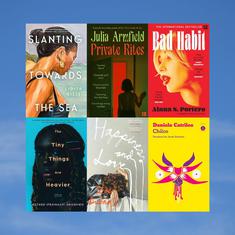Now, his latest adventure in the book trade leaves a similar trail of confusion. Is The Strange Library, a lavishly, quirkily and self-consciously illustrated combination of image and text a representation of where fiction can go in the digital age, or is it a gimmick to sell a story of less than thousand words at an overpriced £12.99 (about Rs 1,300) just before Christmas?
Translated into English only now, but not a recent book, The Strange Library was published in Japan back in 2008. It tells of a young boy whose mother is expecting him home for dinner, but who blunders into a library where he himself might become the librarian’s dinner. Considering the lack of length, revealing any more of the lot would give the entire game away.
Most Murakami tropes are in attendance in this fable or extended nightmare. There’s food, there’s a mysterious girl, there’s no cat but there’s a bird. And, most of all, there’s the consistent logic of a dream in the storyline. For anyone who’s unwilling to try a full-length novel by the Japanese rock star of contemporary literature, here’s a shortcut to his writing.
The real value of this volume, however, lies in the interplay of visuals and text, with the latter often flowing into the former. It is, in a word, beautiful, and the whimsical images enhance the unpredictability of what is, nevertheless, a tightly controlled narrative. Ted Goossen’s translation runs just as effortlessly as Murakami’s unencumbered and luminous storytelling.
But what to make of this strange tale? The identity of the writer forces attention to what might have been passed off as a smart story had someone else written it. The metaphor of eating brains crammed with knowledge is too delicious to ignore, as is the narrator’s Kafkaesque predicament of being imprisoned without any obvious reason.
Are books and knowledge meant to be a jail, then, breaking out of which can only mean deep personal loss? As usual, Murakami provokes a search of one’s own soul, forcing us to weigh the price we have to pay to get what we seek. This is a story which takes far less time to read than to ponder over.
Here, then, are the seven reasons to read The Strange Library.
7. How often do you get to read TWO new Murakamis in one year? Don’t forget that Colorless Tsukuru Tazaki and his Years of Pilgrimage were released earlier in 2014.
6. It’s a beautiful, beautiful, book. In fact, the UK and US editions have different designs, and both are worth buying and preserving.
5. There are no cats. Welcome relief.
4. It’s the quickest way to find out what Murakami writes about. Definitely better than reading Wikipedia pages.
3. It’s, as the cliché goes, unputdownable. You have to read till the end to find out what happened. Does the boy escape?
2. For passages such as this: ‘“I get it,” I said. “Our worlds are all jumbled together – your world, my world, the sheep man’s world. Sometimes they overlap and sometimes they don’t. That’s what you mean, right?”’
1. And the number one reason is: This book is about loneliness. And who isn’t lonely?










